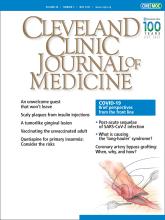A 40-year-old woman presented with a 1-year history of an enlarging mass on the maxillary gingiva. The mass had been resected 4 years ago but had grown back. She said that she was otherwise in good health.
Examination revealed a nodule—well-circumscribed, smooth, elastic, hard, measuring 20 mm by 18 mm—on the left maxillary anterior gingiva (Figure 1). In addition, the left maxillary second incisor was hypermobile, with poor-quality dental restorations. Examination of the neck found no cervical lymphadenopathy.
A well-circumscribed, smooth-surfaced, elastic, hard nodule, 20 mm by 18 mm, on the left maxillary anterior gingiva.
Computed tomography showed a well-demarcated, rim-enhanced soft-tissue mass in the left maxillary anterior gingiva with slight bone resorption at the left maxillary second incisor (Figure 2).
Computed tomography shows a well-demarcated, rim-enhanced soft tissue mass in the left maxillary anterior gingiva (A, arrow), with slight bone resorption at the left maxillary second incisor (B, arrow).
Biopsy was performed, and histopathologic study revealed keratinized epithelium overlying fibrous connective tissue with infiltration of inflammatory cells.
Based on these findings, we diagnosed recurrent fibrous epulis, resected the nodule, and extracted the loose tooth. At follow-up 20 months later there was no evidence of recurrence.
CLINICAL RECOGNITION AND DIAGNOSIS
Fibrous epulis, a type of inflammatory fibrous hyperplasia of the gingiva, is a relatively common tumorlike lesion.1,2 The possible origin is the periosteum and the periodontal ligament.1,2 Factors that lead to its development are local irritations such as poor-quality dental restorations, dental plaque, and calculus.2,3
The estimated prevalence of fibrous epulis is 0.09%. It occurs at a wide range of ages and in women more often than men.4 Most lesions occur on the maxillary anterior interdental papilla.1,2,4
Clinically, fibrous epulis is an asymptomatic, exophytic, smooth-surfaced or focally ulcerated, mucosal-colored mass with a variable growth rate.2,3 At presentation, most lesions are 10 mm to 20 mm in diameter; those that are large or grow rapidly tend to be misdiagnosed as neoplastic.2,3
On computed tomography, lesions appear as a soft-tissue mass in the gingiva with mild enhancement, and up to one-third contain calcifications that can be easily seen.1,3 These calcified lesions are termed mineralizing fibrous epulis or peripheral ossifying fibroma.1 Bone resorption is relatively uncommon.5
Histologically, fibrous epulis shows hyper-plastic epithelium that overlies fibrous connective tissue.1 Mineralized tissue, if present, consists of trabeculae or droplike metaplastic bone.1
The differential diagnosis includes pyogenic granuloma, peripheral giant cell granuloma, fibroma, peripheral odontogenic fibroma, fibrosarcoma, and squamous cell carcinoma.1,3,5 A slowly growing mass on the interdental papilla with local irritations and calcifications detected by computed tomography should raise suspicion of fibrous epulis.3 However, distinguishing fibrous epulis from the other conditions listed above may be difficult, and thus, histopathologic study is crucial.2,3
TREATMENT
Complete excision and curettage of the lesion is the preferred treatment because the recurrence rate is high, from 7% to 45%.3 Therefore, long-term follow-up is essential. Tooth extraction is not indicated unless there is underlying bone resorption.
DISCLOSURES
The authors report no relevant financial relationships which, in the context of their contributions, could be perceived as a potential conflict of interest.
- Copyright © 2021 The Cleveland Clinic Foundation. All Rights Reserved.








